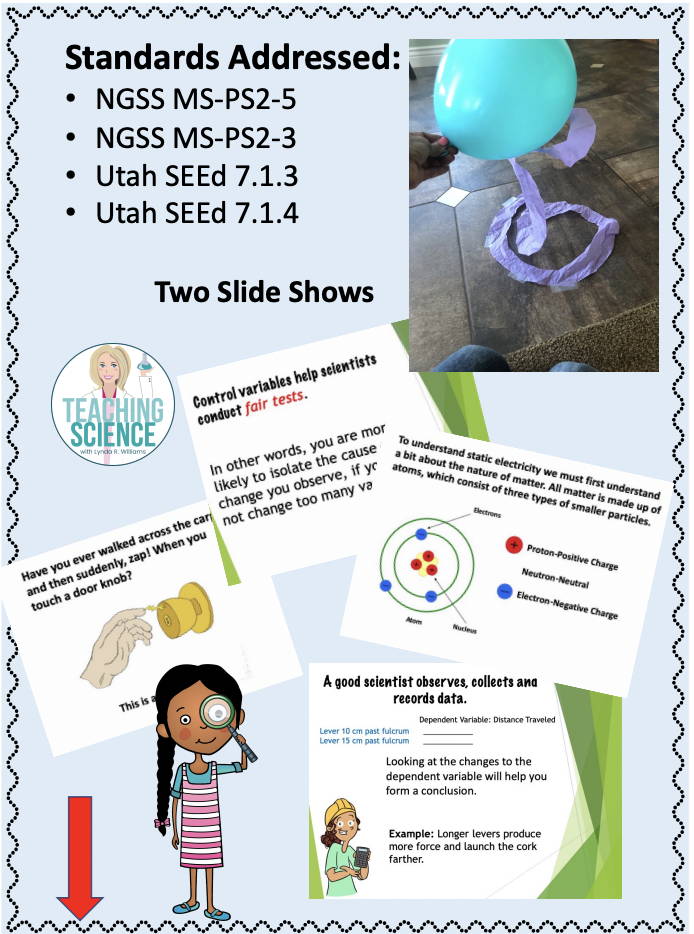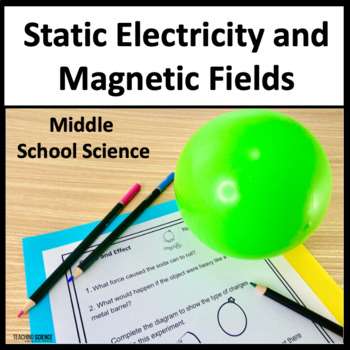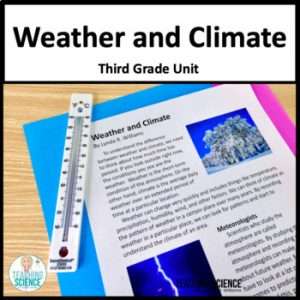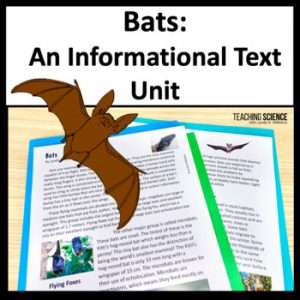Description
Do you need to teach static electricity and magnetism? Both magnetic fields and static electric fields will be examined. We cannot see these fields, but we can see the forces they exert on each other even when objects are not touching. This is a vast resource addressing several standards. There are 98 pages in this unit on static electricity for Middle School. Students will learn about energy fields by studying these two topics (static electricity and magnetism) and will be able to demonstrate a field through a hands-on activity.
Students will also use engineering skills to create an electromagnet, and then they will test it using Fair Test practices to see if they can influence the strength of their electromagnet.
This Resource Includes:
- a slide show on static electricity
- six labs
- follow-up pages
- three pages of informational text
- word wall words
- a quiz
Teachers Love This Resource!
Camille ⭐️ ⭐️ ⭐️ ⭐️ ⭐️ Extremely Satisfied
Great resource. My students loved the exciting labs! They really seemed to learn the material. This is a really well-designed unit and aligns with the standards.
Jennifer ⭐️ ⭐️ ⭐️ ⭐️ ⭐️ Extremely Satisfied
Great unit on fields. It is hard to teach about something that you cannot see! This unit is perfect for showing the evidence of fields. My students were completely engaged.
A slide show on static electricity will give background information on the atomic structure and the interaction of electrons in simple terms that middle school science students can understand. This resource includes six labs in the 5 E format. The unit also includes follow-up pages for each lab.
A three-page article on magnetism is included with comprehension questions. Students will practice reading informational text skills aligned with CCSS. Word Wall Words are included.
Students will also make a model of electrons moving to create charge imbalance and static discharge. This aligns with MS PS1-1 and will help students make a model showing several molecules’ electrons and protons.
This resource is aligned with NGSS Motion and Stability: Forces and Interactions
NGSS MS-PS2-5. Conduct an investigation and evaluate the experimental design to provide evidence that fields exist between objects exerting forces on each other even though the objects are not in contact.
MS-PS2-3. Ask questions about data to determine the factors that affect the strength of electric and magnetic forces. [Clarification Statement: Examples of devices that use electric and magnetic forces could include electromagnets, electric motors, or generators.
MS PS1-1. Develop models to describe the atomic composition of simple molecules and extended structures (partially addressed in this resource).
You will need some magnets and, other than that, just easy-to-find materials: balloons, tissue paper, an empty aluminum can, salt, and paper clips.
Also aligned with Utah SEEd 7th grade
Standard 7.1.3
Construct a model using observational evidence to describe the nature of fields that exist between objects that exert forces on each other even though the objects are not in contact. Emphasize the cause-and-effect relationship between properties of objects (such as magnets or electrically charged objects) and the forces they exert.
Standard 7.1.4
Collect and analyze data to determine the factors that affect the strength of electric and magnetic forces. Examples could include electromagnets, electric motors, or generators. Examples of data could include the effect of the number of turns of wire on the strength of an electromagnet, or of increasing the number or strength of magnets on the speed of an electric motor.
Science Concepts Include:
- Charge imbalance
- Static discharge
- Magnetic poles
- Attract and repel
- Basic atomic structure
- Equilibrium
- Magnetic field
- Static electric field
- Making a model
- Providing Evidence
- Asking Questions
- Fair Tests
- Independent Variable
- Dependent Variable


Purchase in the bundle Forces and Interactions for Middle School and Save 20%






